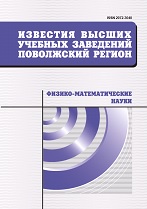|
Physics
Optimization of electron - electromagnetic field interactions in the resonator interaction gap through extendingthe drift tube hole's diameter
M. Yu. Zakharchenkoa, Yu. F. Zakharchenkob
a Yuri Gagarin State Technical University of Saratov, Saratov
b Saratov branch of the Institute of Radio Engineering and Electronics of RAS, Saratov
Abstract:
Background. In a traveling wave tube (TWT), high-gain amplification processes and electron efficiency found along the chain of coupled resonators with the bandwidth about 30...120 GHz, are obtained when the diameter d of the hole in the resonator drift tube equals 0,75...1,5 from the $\Delta$ width of the interaction gap. Within the bandwidth of 200...300 GHz, in order to provide the required amplifica-tion coefficient and electron efficiency and preserve the optimum value for $d / \Delta$, the electron beam with the current density up to 500 А/см$^{2 }$and the potential up to 25 kW must be induced in the hole with d no less than 0,2 mm. However, under these conditions the construction of the electron-optical system is most sophisticated, and designing holes for the resonator drift tube is highly problematic, since application of the welding and electroerosion technologies is hardly possible. Based on the theory, we showed that electron efficiency along the chain of coupled resonators of TWTs with 200...300 GHz will be lower than 1%. Therefore, when designing TWTs it will be appropriate to achieve higher interaction intensity of electrons with high frequency fields within the interaction gap, rather than upgrade electron efficiency. In this case, the amplification coefficient and output high-frequency power will grow, since interaction activity occurs in the peripheral area of the beam cross-section, which grows together with the increase of $d / \Delta$. The aim of the research is to consider the theory of the basic operating principles relating the increase in the interaction activity of electrons with high frequency fields within the interaction gap due to the increase of $d / \Delta$. Materials and methods. To analyze the basic principles we used the mathematical tools. Thus interaction of electrons and high-frequency fields in the interaction gap is considered in terms of linear approximation, while electrodynamic part of the problem was considered in terms of quasi-electro-static approximation. We investigated the model presented as a gap with the width $\Delta$ between the flat boundaries of conducting half-spaces, where the location of two circular drift tubes of d diameter is coaxial. It is assumed that the actual electric high frequency potential $V_{\Delta}$ operating in the gap, changes in the direction of cross section in line with the principle, which corresponds to the changes acting in the same direction of the component of high frequency field intensity in the cylindrical resonator. Analytic description of distribution of the field-intensity component within the interaction gap is conducted by means of functional series composed from solutions to the Laplace's equation. The coefficients in the series are found from solving a system of linear equations. The latter result from equating longitudinal and transverse components of the field intensity over the common cylindrical boundary of d diameter and further expansion of the resulting expressions into Fourier series by trigonometric functions. To analyze interaction activity in the interaction gap, we used integral expressions for the bunched electron beam and capacity of its interaction with high frequency fields. Results. The provided calculations refer distribution of the intensity-field component along the interaction gap spacing, which has been applied to estimate the dependence of the interaction intensity coefficient ($K_{int}$) from $d / \Delta$.
Conclusions. It is shown that $K_{int }$grows as the d /$\Delta$ is increased, and is at the maximum when $d / \Delta$ equals 4,25...4,75. These variables for $K_{int}$ exceed the value of $K_{int}$ given for $d /\Delta$ and equal to 0,75...1,5, by 3...5 times. The maximum variable of K$_{int}$ reaches its top value when the angle of the electron transit through the interaction gap equals 3p/8. The variables of $d / \Delta$ when equal to 4,25...4,75, are lower than the critical dimension $d_{кр} / \Delta$ in the drift tube, where we find the process of electrodynamic coupling between the adjacent resonators.
Keywords:
millimeter waves, traveling wave tube, a chain of coupled cavity resonators, growth in interaction activity of electrons and the high frequency field in the interaction gap.
Citation:
M. Yu. Zakharchenko, Yu. F. Zakharchenko, “Optimization of electron - electromagnetic field interactions in the resonator interaction gap through extendingthe drift tube hole's diameter”, University proceedings. Volga region. Physical and mathematical sciences, 2018, no. 1, 164–174
Linking options:
https://www.mathnet.ru/eng/ivpnz173 https://www.mathnet.ru/eng/ivpnz/y2018/i1/p164
|

| Statistics & downloads: |
| Abstract page: | 38 | | Full-text PDF : | 31 | | References: | 16 |
|




 Contact us:
Contact us: Terms of Use
Terms of Use
 Registration to the website
Registration to the website Logotypes
Logotypes







 Citation in format
Citation in format 